 Technology peripherals
Technology peripherals
 AI
AI
 A few lines of code stabilize UNet! Sun Yat-sen University and others proposed the ScaleLong diffusion model: from questioning Scaling to becoming Scaling
A few lines of code stabilize UNet! Sun Yat-sen University and others proposed the ScaleLong diffusion model: from questioning Scaling to becoming Scaling
A few lines of code stabilize UNet! Sun Yat-sen University and others proposed the ScaleLong diffusion model: from questioning Scaling to becoming Scaling
In the standard UNet structure, the scaling coefficient  on the long skip connection is generally 1.
on the long skip connection is generally 1.
However, in some well-known diffusion model work, such as Imagen, Score-based generative model, and SR3, etc., they all set 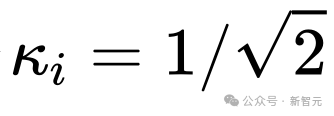 , and found that such a setting can effectively accelerate the training of the diffusion model.
, and found that such a setting can effectively accelerate the training of the diffusion model.
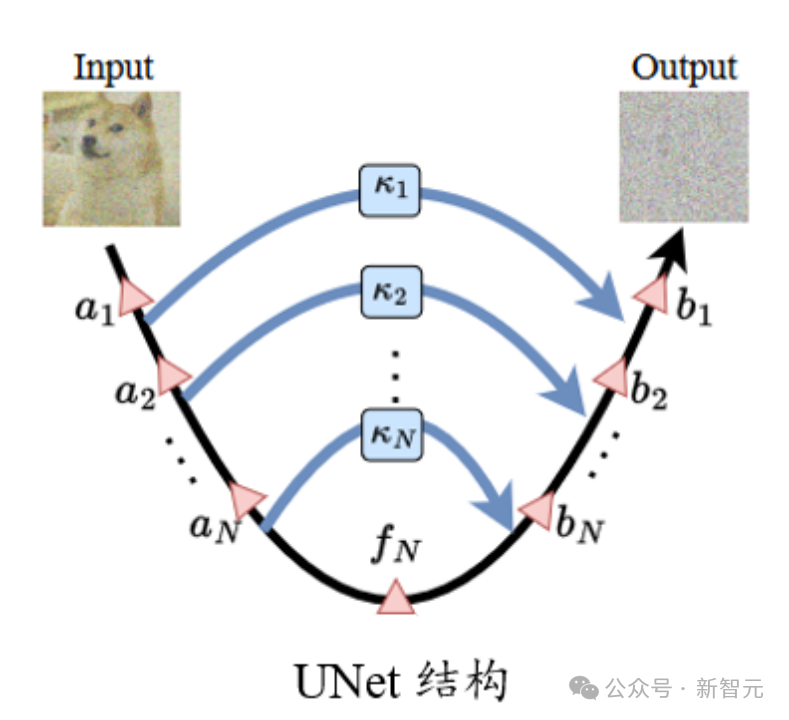

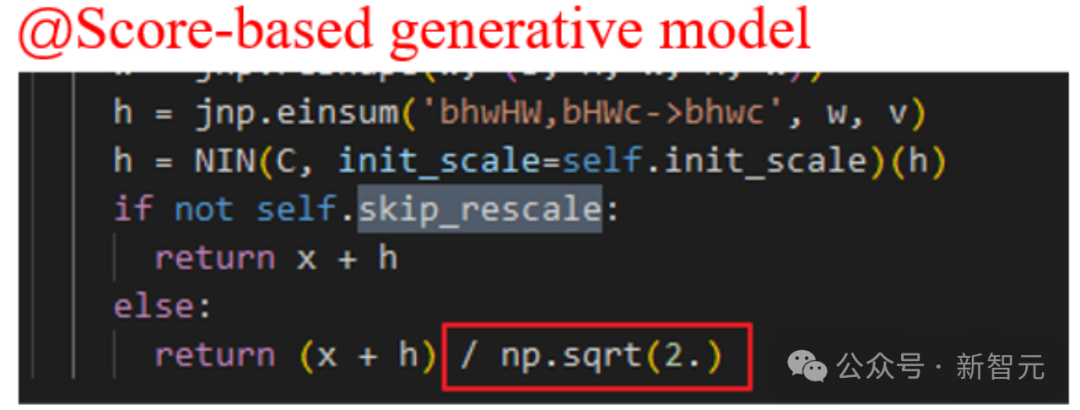
However, Imagen and other models have limited support for skip connection. There is no specific analysis of the Scaling operation in the original paper, but it is said that this setting will help speed up the training of the diffusion model.
First of all, this kind of empirical display makes us unclear about what role this setting plays?
In addition, we don’t know whether we can only set  , or can we use other constants?
, or can we use other constants?
Are the "status" of skip connections at different locations the same? Why use the same constant?
The author has a lot of questions about this...
 Picture
Picture
Generally speaking, compared with ResNet and Transformer structures, UNet is not "deep" in actual use, and is less prone to optimizations such as gradient disappearance that are common in other "deep" neural network structures. question.
In addition, due to the particularity of the UNet structure, shallow features are connected to deep locations through long skip connections, thus further avoiding problems such as gradient disappearance.
Then think about it the other way around, if such a structure is not paid attention to, will it lead to problems such as excessive gradients and parameter (feature) oscillation due to updates?
 Picture
Picture
#By visualizing the characteristics and parameters of the diffusion model task during the training process, it can be found that there is indeed instability Phenomenon.
The instability of parameters (features) affects the gradient, which in turn affects parameter updates. Ultimately this process has a greater risk of undesirable interference with performance. Therefore, we need to find ways to control this instability.
Further, for the diffusion model. The input of UNet is a noisy image. If the model is required to accurately predict the added noise, this requires the model to have strong robustness to the input against additional disturbances.
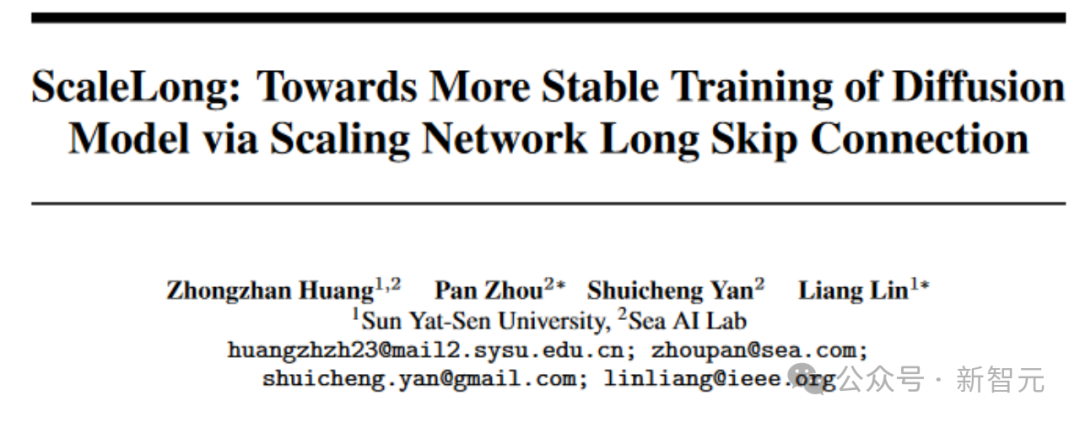

From theorem 3.1, the oscillation range of the middle layer feature (the width of the upper and lower bounds) is directly related to the sum of the squares of the scaling coefficient. Appropriate scaling coefficients help alleviate feature instability.
However, it should be noted that if the scaling coefficient is directly set to 0, the shock is indeed optimally alleviated. (Manual dog head)
But if UNet degrades to a skip-less situation, the instability problem is solved, but the representation ability is also lost. This is a trade-off between model stability and representational capabilities.
 Picture
Picture
Similarly, from the perspective of parameter gradient. Theorem 3.3 also reveals that the scaling coefficient controls the magnitude of the gradient.
 Picture
Picture
Further, Theorem 3.4 also reveals that scaling on the long skip connection can also affect the robustness of the model to input disturbances. bounds to improve the stability of the diffusion model to input disturbances.
Become Scaling
Through the above analysis, we understand the importance of scaling on Long skip connection for stable model training ,  is also applicable to the above analysis.
is also applicable to the above analysis.
Next, we will analyze what kind of scaling can have better performance. After all, the above analysis can only show that scaling is good, but it cannot determine what kind of scaling is the best or better. good.
A simple way is to introduce a learnable module for long skip connection to adaptively adjust scaling. This method is called Learnable Scaling (LS) Method. We use a SENet-like structure, as shown below (the U-ViT structure considered here is very well organized, like!)
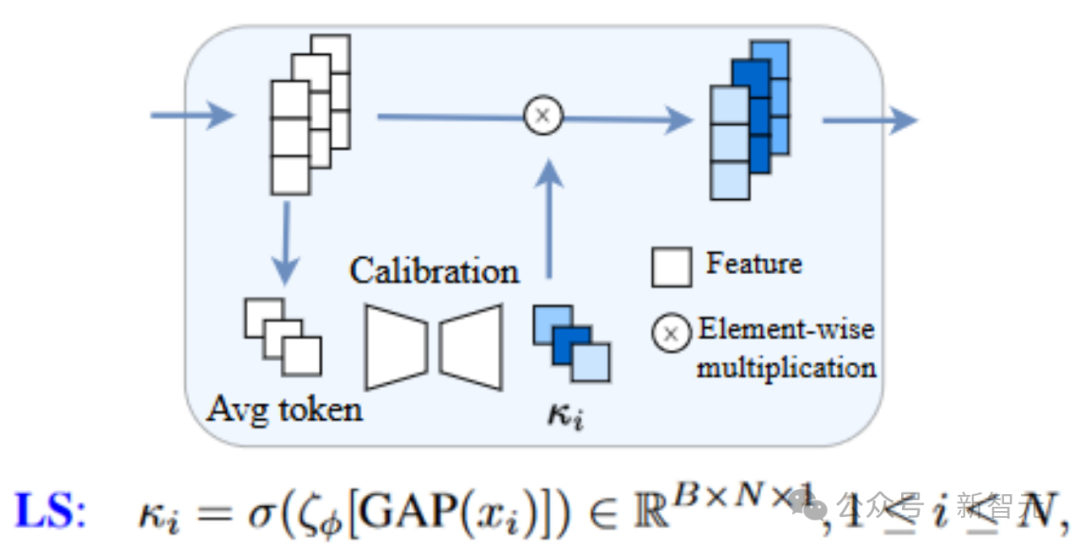 Picture
Picture
Judging from the results of this article, LS can indeed effectively stabilize the training of the diffusion model! Further, we try to visualize the coefficients learned in LS.
As shown in the figure below, we will find that these coefficients show an exponential downward trend (note that the first long skip connection here refers to the connection connecting the first and last ends of UNet), and the first coefficient is almost close to Yu 1, this phenomenon is also amazing!
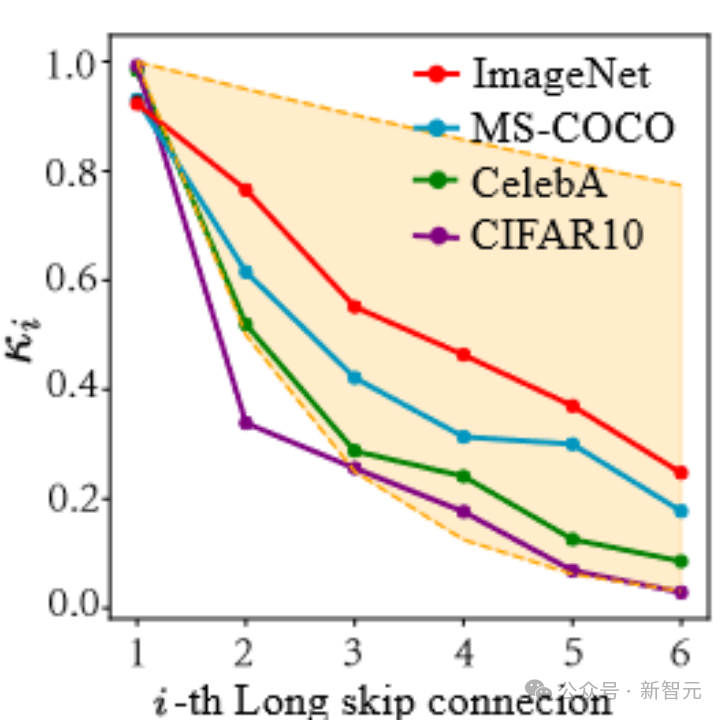 Picture
Picture
Based on this series of observations (please refer to the paper for more details), we further proposed the Constant Scaling (CS) Method , that is, no learnable parameters are required:

CS strategy is the same as the original scaling operation using  without additional parameters, resulting in almost no additional computational cost.
without additional parameters, resulting in almost no additional computational cost.
Although CS does not perform as well as LS in stable training most of the time, it is still worth a try for the existing  strategies.
strategies.
The implementation of the above CS and LS is very simple and only requires a few lines of code. For each (hua) formula (li) and each (hu) type (shao) UNet structure, the feature dimensions may need to be aligned. (Manual dog head 1)
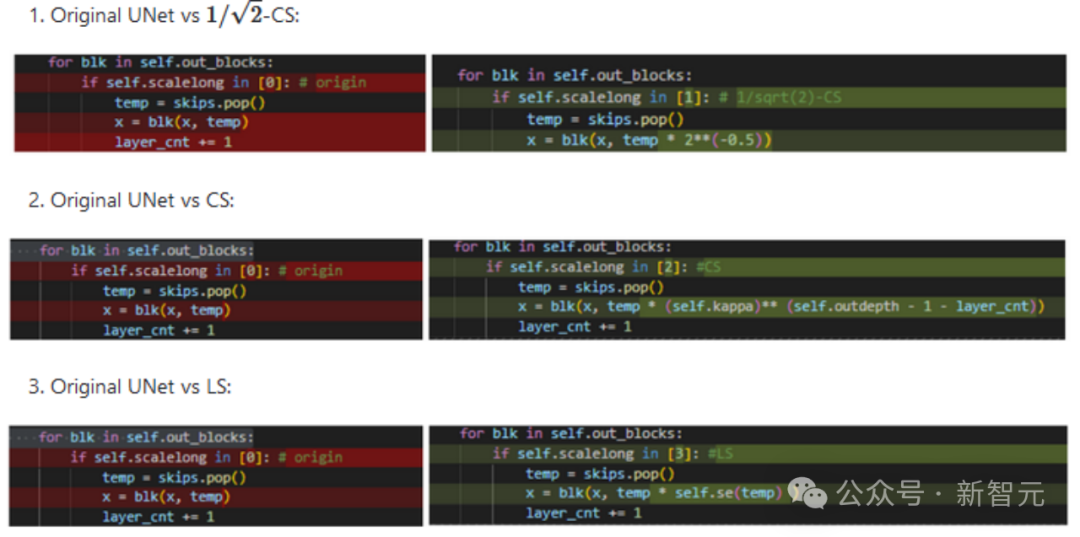
Recently, some follow-up work, such as FreeU, SCEdit and other work, have also revealed the importance of scaling on skip connection. Everyone is welcome to try and promote it.
The above is the detailed content of A few lines of code stabilize UNet! Sun Yat-sen University and others proposed the ScaleLong diffusion model: from questioning Scaling to becoming Scaling. For more information, please follow other related articles on the PHP Chinese website!

Hot AI Tools

Undresser.AI Undress
AI-powered app for creating realistic nude photos

AI Clothes Remover
Online AI tool for removing clothes from photos.

Undress AI Tool
Undress images for free

Clothoff.io
AI clothes remover

AI Hentai Generator
Generate AI Hentai for free.

Hot Article

Hot Tools

Notepad++7.3.1
Easy-to-use and free code editor

SublimeText3 Chinese version
Chinese version, very easy to use

Zend Studio 13.0.1
Powerful PHP integrated development environment

Dreamweaver CS6
Visual web development tools

SublimeText3 Mac version
God-level code editing software (SublimeText3)

Hot Topics
 Open source! Beyond ZoeDepth! DepthFM: Fast and accurate monocular depth estimation!
Apr 03, 2024 pm 12:04 PM
Open source! Beyond ZoeDepth! DepthFM: Fast and accurate monocular depth estimation!
Apr 03, 2024 pm 12:04 PM
0.What does this article do? We propose DepthFM: a versatile and fast state-of-the-art generative monocular depth estimation model. In addition to traditional depth estimation tasks, DepthFM also demonstrates state-of-the-art capabilities in downstream tasks such as depth inpainting. DepthFM is efficient and can synthesize depth maps within a few inference steps. Let’s read about this work together ~ 1. Paper information title: DepthFM: FastMonocularDepthEstimationwithFlowMatching Author: MingGui, JohannesS.Fischer, UlrichPrestel, PingchuanMa, Dmytr
 The world's most powerful open source MoE model is here, with Chinese capabilities comparable to GPT-4, and the price is only nearly one percent of GPT-4-Turbo
May 07, 2024 pm 04:13 PM
The world's most powerful open source MoE model is here, with Chinese capabilities comparable to GPT-4, and the price is only nearly one percent of GPT-4-Turbo
May 07, 2024 pm 04:13 PM
Imagine an artificial intelligence model that not only has the ability to surpass traditional computing, but also achieves more efficient performance at a lower cost. This is not science fiction, DeepSeek-V2[1], the world’s most powerful open source MoE model is here. DeepSeek-V2 is a powerful mixture of experts (MoE) language model with the characteristics of economical training and efficient inference. It consists of 236B parameters, 21B of which are used to activate each marker. Compared with DeepSeek67B, DeepSeek-V2 has stronger performance, while saving 42.5% of training costs, reducing KV cache by 93.3%, and increasing the maximum generation throughput to 5.76 times. DeepSeek is a company exploring general artificial intelligence
 KAN, which replaces MLP, has been extended to convolution by open source projects
Jun 01, 2024 pm 10:03 PM
KAN, which replaces MLP, has been extended to convolution by open source projects
Jun 01, 2024 pm 10:03 PM
Earlier this month, researchers from MIT and other institutions proposed a very promising alternative to MLP - KAN. KAN outperforms MLP in terms of accuracy and interpretability. And it can outperform MLP running with a larger number of parameters with a very small number of parameters. For example, the authors stated that they used KAN to reproduce DeepMind's results with a smaller network and a higher degree of automation. Specifically, DeepMind's MLP has about 300,000 parameters, while KAN only has about 200 parameters. KAN has a strong mathematical foundation like MLP. MLP is based on the universal approximation theorem, while KAN is based on the Kolmogorov-Arnold representation theorem. As shown in the figure below, KAN has
 Hello, electric Atlas! Boston Dynamics robot comes back to life, 180-degree weird moves scare Musk
Apr 18, 2024 pm 07:58 PM
Hello, electric Atlas! Boston Dynamics robot comes back to life, 180-degree weird moves scare Musk
Apr 18, 2024 pm 07:58 PM
Boston Dynamics Atlas officially enters the era of electric robots! Yesterday, the hydraulic Atlas just "tearfully" withdrew from the stage of history. Today, Boston Dynamics announced that the electric Atlas is on the job. It seems that in the field of commercial humanoid robots, Boston Dynamics is determined to compete with Tesla. After the new video was released, it had already been viewed by more than one million people in just ten hours. The old people leave and new roles appear. This is a historical necessity. There is no doubt that this year is the explosive year of humanoid robots. Netizens commented: The advancement of robots has made this year's opening ceremony look like a human, and the degree of freedom is far greater than that of humans. But is this really not a horror movie? At the beginning of the video, Atlas is lying calmly on the ground, seemingly on his back. What follows is jaw-dropping
 AI subverts mathematical research! Fields Medal winner and Chinese-American mathematician led 11 top-ranked papers | Liked by Terence Tao
Apr 09, 2024 am 11:52 AM
AI subverts mathematical research! Fields Medal winner and Chinese-American mathematician led 11 top-ranked papers | Liked by Terence Tao
Apr 09, 2024 am 11:52 AM
AI is indeed changing mathematics. Recently, Tao Zhexuan, who has been paying close attention to this issue, forwarded the latest issue of "Bulletin of the American Mathematical Society" (Bulletin of the American Mathematical Society). Focusing on the topic "Will machines change mathematics?", many mathematicians expressed their opinions. The whole process was full of sparks, hardcore and exciting. The author has a strong lineup, including Fields Medal winner Akshay Venkatesh, Chinese mathematician Zheng Lejun, NYU computer scientist Ernest Davis and many other well-known scholars in the industry. The world of AI has changed dramatically. You know, many of these articles were submitted a year ago.
 The vitality of super intelligence awakens! But with the arrival of self-updating AI, mothers no longer have to worry about data bottlenecks
Apr 29, 2024 pm 06:55 PM
The vitality of super intelligence awakens! But with the arrival of self-updating AI, mothers no longer have to worry about data bottlenecks
Apr 29, 2024 pm 06:55 PM
I cry to death. The world is madly building big models. The data on the Internet is not enough. It is not enough at all. The training model looks like "The Hunger Games", and AI researchers around the world are worrying about how to feed these data voracious eaters. This problem is particularly prominent in multi-modal tasks. At a time when nothing could be done, a start-up team from the Department of Renmin University of China used its own new model to become the first in China to make "model-generated data feed itself" a reality. Moreover, it is a two-pronged approach on the understanding side and the generation side. Both sides can generate high-quality, multi-modal new data and provide data feedback to the model itself. What is a model? Awaker 1.0, a large multi-modal model that just appeared on the Zhongguancun Forum. Who is the team? Sophon engine. Founded by Gao Yizhao, a doctoral student at Renmin University’s Hillhouse School of Artificial Intelligence.
 Kuaishou version of Sora 'Ke Ling' is open for testing: generates over 120s video, understands physics better, and can accurately model complex movements
Jun 11, 2024 am 09:51 AM
Kuaishou version of Sora 'Ke Ling' is open for testing: generates over 120s video, understands physics better, and can accurately model complex movements
Jun 11, 2024 am 09:51 AM
What? Is Zootopia brought into reality by domestic AI? Exposed together with the video is a new large-scale domestic video generation model called "Keling". Sora uses a similar technical route and combines a number of self-developed technological innovations to produce videos that not only have large and reasonable movements, but also simulate the characteristics of the physical world and have strong conceptual combination capabilities and imagination. According to the data, Keling supports the generation of ultra-long videos of up to 2 minutes at 30fps, with resolutions up to 1080p, and supports multiple aspect ratios. Another important point is that Keling is not a demo or video result demonstration released by the laboratory, but a product-level application launched by Kuaishou, a leading player in the short video field. Moreover, the main focus is to be pragmatic, not to write blank checks, and to go online as soon as it is released. The large model of Ke Ling is already available in Kuaiying.
 The U.S. Air Force showcases its first AI fighter jet with high profile! The minister personally conducted the test drive without interfering during the whole process, and 100,000 lines of code were tested for 21 times.
May 07, 2024 pm 05:00 PM
The U.S. Air Force showcases its first AI fighter jet with high profile! The minister personally conducted the test drive without interfering during the whole process, and 100,000 lines of code were tested for 21 times.
May 07, 2024 pm 05:00 PM
Recently, the military circle has been overwhelmed by the news: US military fighter jets can now complete fully automatic air combat using AI. Yes, just recently, the US military’s AI fighter jet was made public for the first time and the mystery was unveiled. The full name of this fighter is the Variable Stability Simulator Test Aircraft (VISTA). It was personally flown by the Secretary of the US Air Force to simulate a one-on-one air battle. On May 2, U.S. Air Force Secretary Frank Kendall took off in an X-62AVISTA at Edwards Air Force Base. Note that during the one-hour flight, all flight actions were completed autonomously by AI! Kendall said - "For the past few decades, we have been thinking about the unlimited potential of autonomous air-to-air combat, but it has always seemed out of reach." However now,





